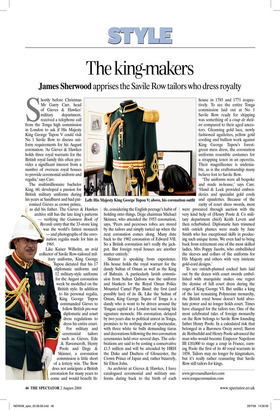The king-makers
James Sherwood apprises the Savile Row tailors who dress royalty Shortly before Christmas Mr Garry Carr, head of Gieves & Hawkes’ military department, received a telephone call from the Tonga high commission in London to ask if His Majesty King George Tupou V could visit No 1 Savile Row to discuss uniform requirements for his August coronation. ‘As Gieves & Hawkes holds three royal warrants for the British royal family this often provides a significant interest from a number of overseas royal houses to provide ceremonial uniform and regalia,’ says Carr.
The multimillionaire bachelor King, 60, developed a passion for British military uniforms during his years at Sandhurst and had patronised Gieves as crown prince, as did his father. The Gieves & Hawkes archive still has the late king’s patterns — verifying the Guinness Book of Records entry that the 33-stone king was the world’s fattest monarch — and photographs of the coronation regalia made for him in 1965.
Like Kaiser Wilhelm, an avid collector of Savile Row-tailored military uniforms, King George Tupou dictated that his 17 diplomatic uniforms and 12 military-style uniforms for the August coronation week be modelled on the British style. In addition to his personal regalia, King George Tupou commanded Gieves to follow British pre-war diplomatic and court dress regulations to dress his entire court. For military and ceremonial tailors such as Gieves, Ede & Ravenscroft, Henry Poole and Dege & Skinner, a coronation commission is little short of a lottery win. The Row does not anticipate a British coronation for many years to come and would benefit lit tle, considering the English peerage’s habit of holding onto things. Dege chairman Michael Skinner, who attended the 1953 coronation, says, ‘Peers and peeresses robes are stored by the tailors and simply tarted up when the next coronation comes along. Many date back to the 1902 coronation of Edward VII. So a British coronation isn’t really the jackpot. But foreign royal houses are another matter entirely.’ Skinner is speaking from experience. His house holds the royal warrant for the dandy Sultan of Oman as well as the King of Bahrain. A particularly lavish commission from Sultan Qaboos was the uniform and blankets for the Royal Oman Police Mounted Camel Pipe Band: the first (and possibly last) of its ilk. Like the Sultan of Oman, King George Tupou of Tonga is a dandy who is wont to be driven around the Tongan capital in a London taxi wearing his signature monocle. His coronation, delayed by two years due to political unrest in Tonga, promises to be nothing short of spectacular, with three white tie balls demanding tiaras and decorations following the two coronation ceremonies held over several days. The celebrations are said to be costing a conservative £1.5 million and will be attended by HRH the Duke and Duchess of Gloucester, the Crown Prince of Japan and, rather bizarrely, Sir Elton John.
As archivist at Gieves & Hawkes, I have catalogued ceremonial and military uniforms dating back to the birth of each house in 1785 and 1771 respectively. To see the entire Tonga commission laid out at No 1 Savile Row ready for shipping was something of a coup de théâtre compared to their aged ancestors. Gleaming gold lace, newly fashioned aguilettes, yellow gold cording and bullion work against King George Tupou’s forestgreen mess dress, the coronation uniforms resemble costumes for a strapping tenor in an operetta. Their magnificence is undeniable, as is the craftsmanship many believe lost to Savile Row.
‘The uniforms were all bespoke and made in-house,’ says Carr. ‘Hand & Lock provided embroideries and specialist gold cords and epaulettes. Because of the rarity of court dress swords, most were procured through auction with the very kind help of (Henry Poole & Co military department chief) Keith Levett and then refurbished. Diplomatic hats trimmed with ostrich plumes were made by Jane Smith who has exceptional skills in producing such unique items. We even had to bring back from retirement one of the most skilled ladies, Mrs Poppy Jacobs, who embellished the sleeves and collars of the uniforms for His Majesty and others with very intricate gold-cord designs.’ To see ostrich-plumed cocked hats laid out by the dozen with court swords embellished with marquisite makes one regret the demise of full court dress during the reign of King George VI. But unlike a king of the last remaining Polynesian monarchy, the British royal house doesn’t hold absolute power and no longer holds court. Times have changed for the tailors too. One of the most celebrated tales of foreign monarchy on the Row belongs to Savile Row founding father Henry Poole. In a calculated risk that belonged in a Baroness Orczy novel, Baron de Rothschild and Henry Poole advanced the man who would become Emperor Napoleon III £10,000 to stage a coup in France, earning Poole the first of its 40 royal warrants in 1858. Tailors may no longer be kingmakers, but it’s really rather reassuring that Savile Row still tailors for kings.
www.gievesandhawkes.com www.tongacoronation.com


























































 Previous page
Previous page